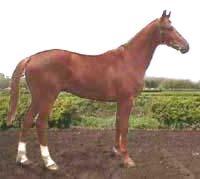|
|
The
Russian Trakehner
Russian Trakehners are superb competition
horses.
They are less demanding than their European cousins |
 |
The Russian Trakehner is slightly different from
its European cousin. It is rangier and lighter and its legs are generally
cleaner, especially cannons and fetlocks. It is an excellent mover. The Russian
Trakehner is used to herd keeping, and hence is more economical to keep.
Although not as enduring as endemic Russian breeds the Russian Trakehner
compares favorably with his cousins from Europe.
Average measurements of Russian
Trakehners (cm)
|
Stallions |
Mares |
| Height |
167.4 |
163.6 |
| Body
length |
170 |
168 |
| Chest
girth |
195 |
192 |
| Bone below the
knee |
21.4 |
20.8 |
Performance of Russian Trakehners
The Trakehner is very popular in Russia
as a competition horse: whereas in the world Trakehners rank the 10th as
dressage and showjumping horses, in Russia Trakehners come second. Some Russian
Trakehners have been extremely successful in sports. The famous Pepel was many
times European and World champion, Topky and Espadron were placed at Olympics,
and Prince (Khokei-Pavana) is now one of the best competition horses in Europe.
Other outstanding Russian Trakehner performers were Kover, Epigraf, Epokha,
Ghercha, Aeron, Tantal, Paket, Fat, Farkhad, Fokus, and many others.
The field for the Gran Pardubice steeplechase in
Czechoslovakia is largely Trakehner.
 |
Temperament
Because of the influence of Thoroughbred blood,
the Trakehner is a highly courageous horse. In Russia Trakehners are carefully
bred for performance, trainability, and manageability
|
Origins
The Trakehner originated in what used to be
East Prussia and is now a part of Russia. In the early 13th century, the
province was colonized by the Order of Teutonic Knights. They established the
Trakehnen studs using the indigenous Schweiken as a base. These ponies were
plain and often common, but they were also tough and hardly. Schweiken Ponies
descend from the Konik Pony — a direct derivative of the primitive Tarpan.
They inherit the Tarpan’s extraordinary natural vigor and powers of
endurance.
In 1732, Friedtich Wilhelm I of Prussia founded the Royal Trakehner Stud
Administration. This stud was the main source of stallions for all Prussia and
the area quickly established a reputation for elegant coach horses. Within 50
years, the emphasis shifted to producing army chargers and remounts of a
quality unsurpassed in Europe. Thereafter, increasing use was made of English
Thoroughbred and Arab blood, which balanced deficiencies of temperament and
constitution.
By 1913, most Trakehner stallions were Thoroughbred. The greatest influence was
Perfectionist, son of Persimmon, who won the English Derby and the St Leger in
1896. The best of his sons, Tempelhuter, provided a powerful line that is
recognized as the foundation for the modern Trakehner.
Conformation
The Trakehner has an excellent conformation,
which, overall, is like that of a Thoroughbred of substance. It is full of the
quality that has earned the breed the title of “noble” — a word
much used in describing what may be regarded as Europe’s finest warmblood.
It also has an unmistakable character and expression, not always so evident in
other warmbloods. It is a wonderfully balanced horse — athletic, agile and
having great freedom of movement at all paces. Russian Trakehners are slightly
rangier, they combine height with a light, powerful build and an overall
elegance of conformation.
The refined head of the Trakehner exemplifies the background of English
Thoroughbred and Arab blood. There is width between the expressive eyes.
The alert, mobile ears are always held well. There is ample length to
the elegant neck. The withers are long. The ideal Trakehner has
good, well-shaped shoulders. The back is strong and often
straight. The loins are muscular. The croup is broad and
powerful. Good, strong limbs and joints are a feature of the
Trakehner. It stands close to the ground on shortish legs and
cannons and has ample bone. The hoofs are often harder
than with other warmbloods.
Trakehners in Russia
Trakehners were first brought to Russia in 1925
from East Prussia. Most of them were used as remounts for the Russian cavalry.
When bred, the mares appeared to be unsuitable for herd keeping and most of
them miscarried.
A second group of Trakehners came to Russia in 1945. They were all concentrated
at the Kirov stud on the Don river. Although the bulk of the breed is still at
that stud, many good individuals are now produced elsewhere, specifically at
private studs. The largest of them is Oros-L
near Kaluga, 200 km away from Moscow.
| Russian Trakehner Stud Book
In 1974 the first volume of the
Russian Trakehner Stud book was issued by the Russian Institute of Horse
Breeding. Six volumes appeared ever since. The Russian Trakehner Stud Book is
related to the German Trakehner Stud Book.
|
 |
Russian Trakehner
Association
In Russia there is a Trakehner association
based at the Russian Institute of Horse Breeding. Its chairwoman is Dr.
Dorofeeva.
Trakehner racing in Russia
Russian Trakehners are raced on the flat and
over hurdles. The following are some of their records:
| 1200 m (6F) — 1 min
17.4 secs 1600 m (1M)
— 1 min 42.0 secs
2000 m (1M 2) — 2 min 11.0
secs
|
2400 m (1M 4) — 2
min 34.0 secs 3200 m (2M)
— 3 min 37.0 secs
|
For further information please visit the
Oros-L Stud
 |
All the information and
photographs for this section were kindly provided by Troika, the ultimate
Russian horse resource online. For further information on Russian horses and
horsemanship please click
here |
|

